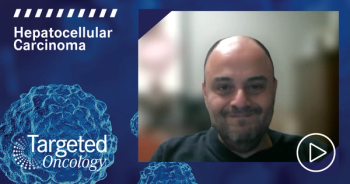
Case 4: QoL Improvement With Treatment of CCA
EXPERT PERSPECTIVE VIRTUAL TUMOR BOARD
Ghassan Abou-Alfa, MD, MBA:There is something much more complex in regard to cholangiocarcinoma, and this is 1 of the things that we need a lot of help with, and this is where we’ll build our friendship with IR [interventional radiology]: biliary resection. Tell us a little more about somebody with cholangiocarcinoma, bilirubin level of 13 mg/dL, which is a classic scenario. This is what we see. What can we do there?
Riad Salem, MD:For cholangiocarcinoma, 1 of the most common manifestations we would see in the patient…is hyperbilirubinemia obstruction, often at the bifurcation. So Klatskin-type physiology, where the CBD [common bile duct] may not be that dilated. Often endoscopic techniques are challenging because there are multiple ducts and segments that are occluded.
One of the things that we do is using PTC ultrasoundpercutaneous transhepatic cholangiography ultrasound—and fluoroscopic guidance. We actually get tubes in there to decompress the patient. And we now have some techniques to do this without leaving tubes. We can decompress the biliary system, lower the bilirubin to allow you guys to treat with systemic agents. We’re able to place the plastic stents, so the GI [gastrointestinal] guys can change them internally into the right segments.
We’re able to streamline for patients to eliminate the jaundice, the itching, the discomfort, etc, and lower the bilirubin to criteria that are, I think, acceptable for youand most of the time in a manner that’s tube-free. This is clearly something that’s very important for this type of physiology. As you mentioned, it’s central and obstructs the bile ducts, and the patients present with jaundice and hyperbilirubinemia. You need to get them on systemic therapy.
Ghassan Abou-Alfa, MD, MBA:From your standpoint, Amit, as a hepatologist, what’s bad about having a high bilirubin, other than we need it for treatment, etc? What are the symptoms?
Amit Singal, MD:The big 1, as Riad already mentioned, is that these patients can be quite pruritic. When you have biliary obstruction, I think from a quality-of-life perspective, that’s 1. But then when somebody else is jaundiced, you can have vitamin deficiency. You can become vitamin K deficient. These other manifestations of the jaundice can actually be quite concerning as well. But from a symptom standpoint, pruritis is by far the most concerning. Of course, from a treatment perspective, there are concerns that the chemotherapy may not be as effective when you’re that jaundiced. So from a treatment perspective, it also facilitates the chemotherapy to be given.
Ghassan Abou-Alfa, MD, MBA:Fair enough. We really covered quite a bit over here about cholangiocarcinoma, a disease that we have known for a long time. If you recall, historically we were talking about what we called unknown primary, and now we have it better defined. Already Farshid mentioned to us, there’s a lot of understanding or better understanding with regard to genetics and biology of cholangiocarcinoma. Thankfully, at least we have standard-of-care therapy, and we have a lot of excitement about positive data that already have been reportedfor example, the ivosidenib—in regard to anti-IDH1or regard to theFGFR2fusion proteins and alsoFGF19, etc. So there’s a lot going on in regard to that disease.
Nonetheless, I think the basics are very important, as already a lot of us brought it up. No. 1 is, make sure we look into the hyperbilirubinemia that can occur, and look at the potential for a diversion of the bilirubinie, via a stent or via drainage. As Riad and Amit mentioned, we want to be sure we balance those things because, of course, on 1 hand, as Amit reminded us, it’s very important to make sure we avoid symptoms. This can be pruritis, the most common one, but this can also be altering the vitamin K deficiency that can lead of course to liver dysfunction as well. Of course, even dehydration has been reported as a hyperbilirubinemia-related symptom.
On the other hand, as Riad warned us, the intervention has to be measured very carefully, because we don’t want to overdo it by, for example, having 3 or 4 or 5 tubes where every bile duct has its own tube to the outside. Because this definitely brings in the potential for infections and too many complications that really, we cannot end up addressing. Nonetheless, back to the same story: multidisciplinary team, early management, a plan for care. Hopefully with the advent of the new therapies, we’ll be able to handle our patients better.
Thank you to Dr Amit Singal, Dr Riad Salem, and Dr Farshid Dayyani for your thoughtful case presentations and lively informative discussion. To our viewing audience, thank you for joining us for theTargeted Oncology™ Virtual Tumor Board® presentation. We hope today’s discussion was a valuable use of your time and that you acquired some practical knowledge that you can take back to your clinic.
Transcript edited for clarity.








































